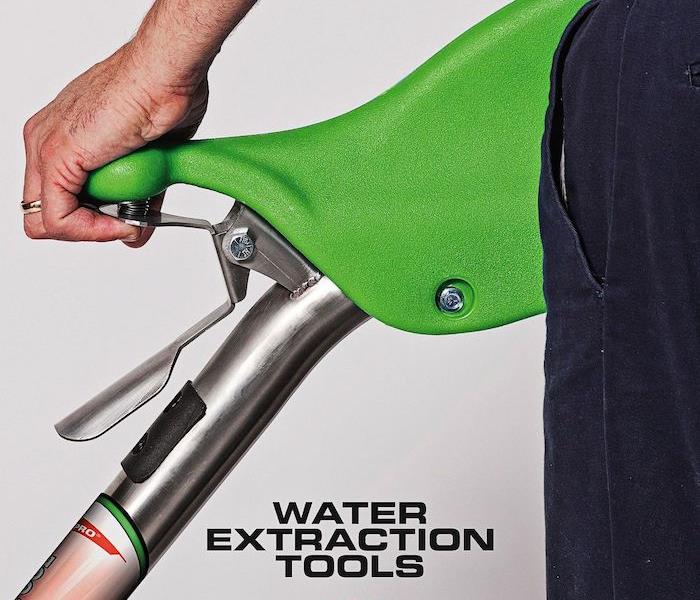How Long Is Water Removal From My Carol Stream Supplies Warehouse Likely To Take?
10/15/2021 (Permalink)
 Our technicians are prepared with the training and state of the art equipment your property needs after a water incident.
Our technicians are prepared with the training and state of the art equipment your property needs after a water incident.
SERVPRO Provides Equipment and A Skilled Team to Help Expedite Water Removal From Your Premises
A burst pipe or other plumbing problem in your Carol Stream supplies store that releases significant amounts of water can paralyze operations or even cause widespread damages. Regardless of what other restoration steps you decide to take, you have to remove the intruding water. SERVPRO has the resources to help any Carol Stream facility handle such removal exercises fast.
Are There Standard Water Extraction Timelines?
When making plans for water removal from your Carol Stream warehouse, you must remember that each situation is unique. Therefore, you should not rely on timelines from other cases you have heard of as your yardstick when trying to establish how long it might take to remove water from your facility. Our SERVPRO technicians can help you get a realistic timeline by considering:
- The total surface area of affected areas
- The percentage of porous and semi-porous materials affected
- Arrangement of fixtures within the structure
The only standard timelines you should worry about are those related to damage to materials in Carol Stream. For instance, mold development, which can affect most organic materials, starts within 24 to 48 hours after such materials are exposed. Dealing with the intruding water before such development becomes permanent damage is crucial. A timely response can prevent many other problems.
In most cases, water removal involves two distinct stages, starting with the extraction of the water pooling on the floor or other surfaces, and after that, drying any wet building materials and contents is essential. The estimated water removal time should factor in how long each stage is likely to take, thus establishing the overall timeline. Normally, the process can take as little as 12 hours to as long as a couple of weeks, depending on the amount of water involved.
Is a Fast Response All it Takes For Efficient Water Removal?
It takes more than a speedy response to remove water from your facility, restoring it to its preloss state. Some of the other important things include:
- Sophisticated water extraction equipment
- Structural drying skills
- An auxiliary resource such as moving equipment
- Building skills
An early start helps in many ways, including minimizing the absorption of water by materials or other forms of moisture migration, thus improving turnaround time. However, other strategies are necessary to manage additional challenges.
One unique challenge of water removal from warehouses is the large open floors, which are also relatively level. Such floors can collect considerable amounts of water even when there are no noticeable water pools. If a casual observation is the only basis for planning the removal, it is possible to underestimate the resources needed for removal. Our SERVPRO crews on their training and experience when planning how to respond to an incident, so we always have suitable resources, including truck-mounted water extractors, which can facilitate the removal of significant water volumes, fast.
How Do Building Skills Help With Water Removal?
Although it is easy to reach most of the spilled water, some filters into hidden areas, especially wall cavities or subfloors. Removing such water may require disassembly or demolition of the affected area. Fixtures within the facility, such as racks or pallets, can also hinder smooth water extraction, necessitating their removal.
Our SERVPRO technicians use a combination of methods to open up different assemblies, whether it is ceilings, walls, or floors. Once open, it is easier to remove water within the cavities. We can drill weep holes to release water from an area such as the ceiling. We can also make cuts on wall panels to open up wet areas for extraction purposes and to remove damaged materials. Such tasks require some building skills to prevent unnecessary destruction of materials. We rebuild the demolished areas after finishing the restoration, eliminating any traces of an incident, "Like it never even happened."
Drying properties affected by water spills is necessary since moisture is destructive to the structure as well as the contents stored in the facility. Leaving wet materials can lead to repetitive mold development and bad odor. High humidity can also damage the contents stored in your facility, mainly if you deal with foodstuffs or electronics. We set up air movers around your facility to expedite evaporation. Dehumidifiers also help extract moisture from the air. Our technicians monitor moisture levels and move the equipment around from time to time to ensure maximum efficiency, thus expediting the drying process.
SERVPRO of Carol Stream / East Bloomingdale has significant experience dealing with a water spill in commercial establishments. Call us at (630) 830-6236 to help restore operations at your Bloomingdale, Glendale Heights, or Addison facility.






 24/7 Emergency Service
24/7 Emergency Service